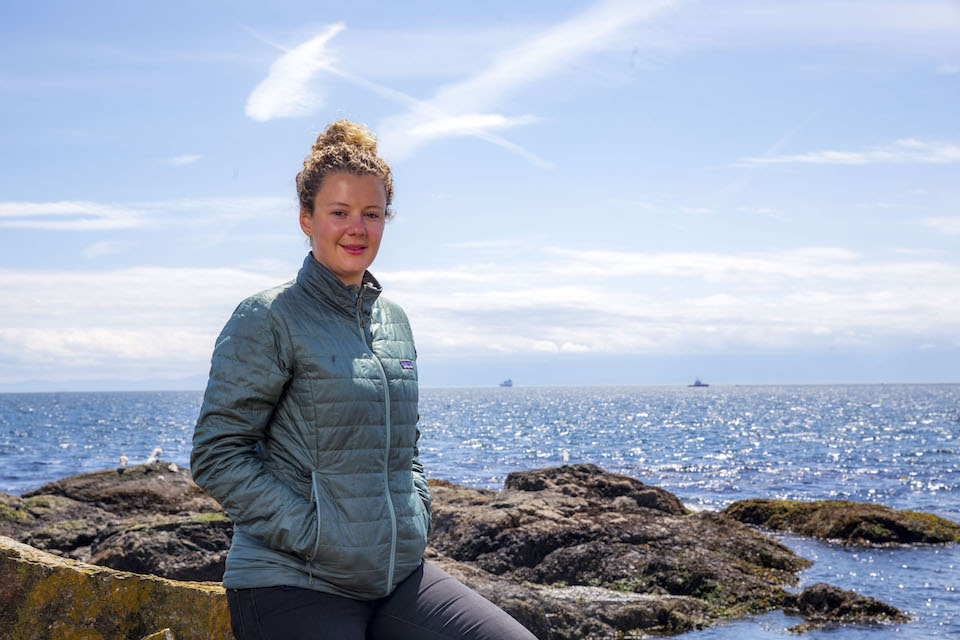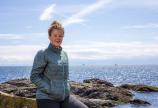Small boat traffic
- Anne MacLaurin

Rise in vessel traffic threatens resident orca population
Large vessel traffic in the Boundary Pass shipping lanes, on the east side of Saturna Island, has been steadily increasing for decades—and the impact on endangered southern resident killer whales (SRKW) is causing considerable concern. UVic marine biologist and coastal geographer Lauren McWhinnie is now looking at how we can also reduce noise pollution from small vessel traffic on this population of whales.
“We know that globally the noise from shipping traffic alone has almost doubled every decade,” says McWhinnie. “Our goal now is to stop increasing noise levels in the SRKW’s key feeding areas.”
For the past four years McWhinnie has been monitoring the growing volume of small boat traffic in key whale foraging sites using three forms of data collection: Automatic Identification System (AIS) receivers, hydrophones (underwater listening devices) and land-based cameras.
These systems shed light on the presence of previously unaccounted-for types of vessel traffic and the time these boats spend in an area, which is important for informing management actions and noise assessment modelling.
There is some evidence that the SRKWs reduce their vocalization rate when there is an increase in boat noise. They rely on sound to communicate with each other, to navigate and for detecting their prey—and boat noise can potentially interrupt these activities.
—UVic marine biologist and coastal geographer Lauren McWhinnie
Graduate students have spent countless hours manually processing data from the cameras, hydrophones and AIS receivers but it’s only recently that this UVic research team has been developing the tools necessary to help automatically and more quickly process the hundreds of thousands of images captured in this study.
For this study, the hydrophones are positioned off of East Point, Saturna Island where they capture low rumbling sounds from commercial vessels passing through the shipping lane as well as the higher frequency sounds from small recreational boats. Both types of noises have the capacity to interrupt the whales’ foraging behaviour.
Data from the past two summers suggest that around 70 per cent of daily boat traffic in Boundary Pass is made up of smaller vessels such as fishing, whale watching and recreational boats, says McWhinnie. These smaller vessels navigate Boundary Pass alongside massive tankers in the summer, and that’s a concern because the summer season is when the SRKW return to this area to forage and socialize.
“Using the cameras, our research shows that some boaters are passing through, while others are staying in these important areas for a longer period of time,” says McWhinnie, noting these kinds of observations help shape policy.
In June, Transport Canada established interim sanctuary zones to protect these key foraging areas.
McWhinnie’s research is funded by the Canadian government’s Oceans Protection Plan and Fisheries and Oceans Canada (DFO); Environment and Climate Change Canada; Marine Environmental Observation Prediction and Response Network.
EdgeWise
The three interim sanctuary zones established by Transport Canada are located on the west side of Pender Island, East Point, Saturna Island and a remote location at Swiftsure Bank. All areas are considered key foraging grounds for the SRKW and no vessels are allowed in the sanctuary zones.
Along with the interim reserve, Transport Canada and DFO introduced management measures that impose mandatory restrictions on vessel and marine mammal interaction.
McWhinnie has been interpreting the new federal laws for community groups such as the Saturna Island Marine Research & Education Society (SIMRES). Through public talks McWhinnie increases public and boater awareness about the impact of marine noise and vessel disturbance on marine mammals and the plight of the SRKW.
“The average small boat owner may be unaware of important SRKW foraging sites, but with some public education people can learn and change their behaviour, such as slowing down in these critical areas,” says McWhinnie.
This summer, McWhinnie worked with SIMRES to launch a campaign #ForTheWhales. The public can review the five top actions that will help reduce the human impact on the SRKW including changing consumer behaviour and increasing awareness of marine hot spots.

